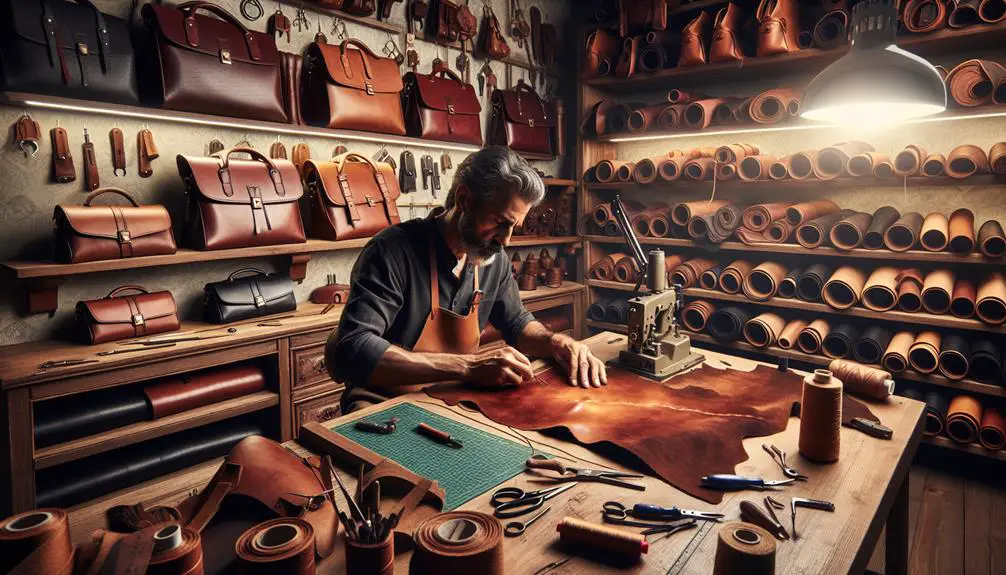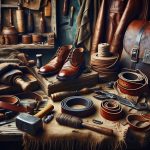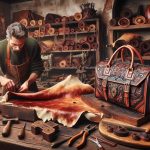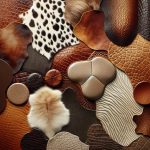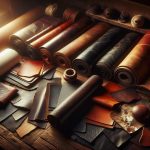Expensive leather usually comes from exotic animals like crocodiles, ostriches, or lizards. It's pretty rare and often has superb quality. Luxury brands love this stuff because it gives their products an exclusive, high-end feel that justifies the hefty price tag. These leathers need special crafting techniques, making them even pricier. Full grain leather, which is top-notch, leads the pack followed by top grain, genuine, and bonded leathers. They're not just durable; they age beautifully, developing a unique patina that leather lovers really dig. Curious about what makes these leathers so special and how to spot the real deal? Stick with me, and let's find out more.
Table of Contents
Key Takeaways
- Expensive leather typically comes from rare exotic hides such as crocodile, alligator, and ostrich.
- It requires unique, artisanal crafting techniques that increase its value.
- The highest grades, like Full Grain Leather, are most prized for their durability and aesthetic qualities.
- Associated with luxury brands, these leathers often carry a high price tag due to exclusivity.
- Maintenance involves regular conditioning and professional care to preserve its luxurious appearance.
Defining Expensive Leather
Expensive leather typically includes premium hides like crocodile, alligator, ostrich, and lizard, known for their rarity and quality. When I talk about these materials, I'm diving into a world where luxury brands reign supreme. These hides are a big deal because they come with a level of exclusivity that sets them apart from your everyday genuine leather.
For instance, crocodile leather is incredibly sought after. It's not just about the distinct texture or the durability; it's the prestige that comes with owning a piece crafted from such a rare material. Luxury brands use this to their advantage, creating products that aren't just accessories but statements. This is why you'll often see a price tag that can make your eyes water. But remember, you're not just buying a handbag or a pair of shoes; you're buying a piece of craftsmanship that's meant to last.
Quality is another cornerstone of expensive leather. These materials undergo meticulous processes to ensure they meet the high standards expected by luxury consumers. It's this combination of rarity, quality, and craftsmanship that justifies the hefty price tag. When you choose an item made from such leather, you're investing in something that elevates your wardrobe to the next level.
Sources of Expensive Leather
When we talk about the sources of expensive leather, we're mainly looking at exotic animal hides and the unique crafting techniques used.
From crocodile to ostrich, these materials aren't just rare; they require expert skills to transform into luxury items.
It's this combination of scarce materials and artisanal craftsmanship that pushes their prices sky-high.
Exotic Animal Hides
Several exotic animal hides, including crocodile, alligator, ostrich, python, and lizard, are used to produce some of the most expensive leather products available. Crocodile skin, in particular, stands out as the priciest, fetching up to $10 per centimeter. This high cost reflects its rarity and the intricate care needed to maintain its luxe appearance.
Here's a quick look at the price comparison and care needs of these exotic leather types:
| Leather Type | Approx. Cost/cm |
|---|---|
| Crocodile | $10 |
| Alligator | $9 |
| Ostrich | $5 |
| Python | $4 |
| Lizard | $3 |
I've always been fascinated by how luxury fashion houses transform these exotic skins into stunning, high-end products.
Artisanal Crafting Techniques
Beyond the exotic materials themselves, the artisanal crafting techniques significantly boost the value of luxury leather goods. These handmade processes, which rely heavily on skilled labor, aren't just about putting pieces together. Each stitch is hand-sewn, each detail uniquely carved, introducing a level of uniqueness and quality you just can't get from mass production.
Think about the meticulous attention to detail, the custom finishes that transform a simple leather bag into a piece of art. This isn't just manufacturing; it's a kind of magic that happens when tradition meets expertise. Limited production runs ensure that each piece isn't just made, but meticulously crafted, making each artisanal leather good a testament to both luxury and time-honored skill.
Crafting Expensive Leather
When it comes to crafting expensive leather, choosing the right raw hides is crucial.
I'll explain the tanning processes that give these leathers their exceptional qualities.
Then, we'll look at the meticulous handcrafting techniques that are necessary to create high-end leather goods.
Selecting Premium Raw Hides
Choosing the right premium raw hides is crucial for crafting high-quality, luxurious leather products. When I'm selecting these hides, I specifically look for ones with minimal imperfections. This not only ensures the leather's aesthetic but also its durability. Most of the top-notch hides come from exotic animals like crocodiles and alligators, often sourced from specialized crocodile farms. These places are meticulous about their breeding and care standards, which results in superior quality animal hides.
The rarity and unique textures of these hides make them highly sought after in the luxury market. It takes not only skilled labor but also a deep understanding of the material to transform these raw hides into high-quality leather. Each piece reflects a fusion of nature's artwork and human craftsmanship.
Tanning Processes Explained
How do we turn quality hides into luxurious leather? The key lies in the tanning processes. Let's dive into how these methods contribute to crafting an expensive type of leather:
- Vegetable Tanning: Utilizes natural tannins from plants like oak. This traditional approach enhances the leather's patina and character over time.
- Chrome Tanning: Involves chromium salts, creating softer, more supple leather that's quite flexible and water-resistant.
- Natural Look: Vegetable tanned leather offers a more organic appearance, appealing to those who appreciate a classic aesthetic.
- Durability: Chrome tanned leather is highly durable, ideal for various luxury goods.
- Cost Influence: Both tanning methods are labor-intensive, influencing the overall expense of the leather due to specialized techniques.
Handcrafting Techniques Detailed
Crafting expensive leather requires a meticulous handcrafting process that highlights the skill and dedication of master artisans. They use traditional tools to perform intricate techniques like hand stitching, edge finishing, and embossing. Each step is crucial, contributing to the luxurious feel and durability of the final product.
For instance, hand-burnished edges and hand-painted finishes aren't just details; they're what make each piece unique and high-quality. It's all about precision and attention to detail. Mastering these handcrafting techniques ensures that each leather good isn't just made—it's crafted with passion and expertise, resulting in pieces that stand out as true examples of superior craftsmanship.
Grading Leather Quality
When assessing the quality of leather, it's crucial to understand the different grades available. As a leather enthusiast, I've learned that the type of leather greatly influences both the product's aesthetic and its durability. Here's a breakdown of the primary grades:
- Full Grain Leather: This is the top dog in the leather world. It comes from the outermost layer of the hide and retains all the natural grain. I find it exceptionally durable and perfect for items that need to withstand a lot of wear and tear.
- Top Grain Leather: A close second, this grade is refined to remove imperfections. It's not as tough as full grain but still offers decent durability and a smoother finish, which I appreciate for high-end bags and jackets.
- Genuine Leather: Don't let the name fool you; it's actually lower on the quality spectrum. It's what I'd go for when I'm not looking for something super durable but still want real leather.
- Bonded Leather: At the bottom of the pile, this one's made by blending leather scraps with synthetics. It's the least durable and I usually avoid it unless budget is my primary concern.
Understanding these grades helps me make informed choices and keep my leather game strong.
Characteristics of Luxury Leather
After exploring the various grades of leather, let's focus on the distinctive qualities that define luxury leather. The world of expensive leather, such as genuine crocodile leather, is steeped in exclusivity and unmatched quality. These premium materials aren't just about aesthetics; they embody durability and a timeless appeal that enhances with age. What sets them apart? It's their unique textures and impeccable finishes.
Luxury leather often boasts characteristics like flawless scales and a softness that's palpable, features you won't find in less costly alternatives. The craftsmanship involved in creating quality leather goods also plays a pivotal role. Artisans dedicate immense skill and attention to detail, ensuring each piece isn't just durable but also a work of art.
Collectors and fashion enthusiasts globally chase after these high-end leather goods, not just for their functionality but for the prestige and style they confer. The rich patina that develops over time doesn't just add character; it increases the material's allure, making it a coveted asset in the realms of luxury fashion. This isn't just leather; it's a statement of elegance and enduring quality.
Care and Maintenance Tips
Maintaining expensive leather requires regular care to keep it looking its best. As a lover of top-quality leather products, I've found that a little attention goes a long way in preserving their beauty and longevity. Here's what works for me:
- Regular Cleaning: I gently wipe my expensive leather items with a damp cloth every few weeks. This helps remove surface dirt and dust that can wear down the leather over time.
- Conditioning: About once every three months, I apply a high-quality leather conditioner. This keeps the leather supple and prevents it from drying out and cracking.
- Proper Storage: I always store my leather goods in a cool, dry place. Direct sunlight is a big no-no as it can fade and even weaken the leather.
- Avoid Harsh Elements: I'm careful to keep my leather items away from harsh chemicals and excessive moisture. These can cause irreversible damage.
- Professional Help: Once a year, I invest in professional cleaning and conditioning. It's a bit of a splurge, but it ensures my expensive leather stays in pristine condition.
Pricing Factors Explained
The cost of expensive leather is heavily influenced by factors such as the type of leather, craftsmanship involved, and its rarity. Let's break it down a bit. You've probably heard of crocodile leather, right? It's one of those exotic leather types that's not only tough to source but also requires intricate craftsmanship to turn into those fancy bags and shoes you see in high-end stores.
Now, the thing about crocodile leather and other exotic leathers is that they aren't just lying around in bulk. Their limited availability really drives up the price. Take the production process, for example—it's no simple task. It demands highly skilled artisans equipped with specialized tools. And because these skills are so specialized, the cost of labor is significantly higher than that of more common leathers.
Moreover, market demand plays a huge role. The higher the demand for these premium leathers, the higher the price climbs. It's classic supply and demand. Everyone wants a piece of luxury, but there's only so much to go around. Combine that scarcity with outstanding craftsmanship and you're looking at some pretty hefty price tags. That's the world of luxury leather for you—rare, refined, and really pricey.
Finding Authentic Leather Goods
When you're in the market for genuine leather goods, knowing how to spot the real deal is crucial. As someone who's delved deep into the world of fashion brands and quality materials, I've picked up a few tricks to ensure I'm getting what I pay for. Here's a quick guide that I use to find authentic leather items:
- Check for Imperfections: Genuine leather will often have natural variations and slight imperfections. Top grain leather, especially, showcases these unique textures.
- Sniff Test: Real leather has a distinct, rich smell that synthetic materials can't replicate. If it smells more like plastic or chemicals, think twice.
- Stitching Quality: Look at the stitching closely. Uneven or loose stitching can be a red flag. Quality craftsmanship should be evident.
- Consider the Source: Purchase from reputable retailers or brands known for using genuine, real leather. It's worth doing a bit of research.
- Price Point: Genuine leather usually comes with a higher price tag. If it's cheap, chances are it's not the real thing.
Frequently Asked Questions
What Type of Leather Is Most Expensive?
The most expensive leather type I've come across is crocodile leather. It's highly prized for its unique texture and durability, often fetching high prices, especially in luxury markets for items like high-end bags.
What Is the Highest Quality Leather?
The highest quality leather is full grain leather. It's extremely durable, tough, and ages beautifully by developing a unique patina. It's the top choice for high-end, long-lasting leather goods.
What Are the 5 Grades of Leather?
The five grades of leather are full grain, top grain, genuine, split grain, and bonded. Each varies in quality, durability, and appearance, catering to different needs and price points.
What Is High End Leather?
High-end leather, like full grain and top grain, is prized for its durability and aesthetic appeal. It's sourced from the best hides and often develops a unique patina, enhancing its beauty over time.
- Why Is Red Velvet Not Red? - April 25, 2024
- How Do You Describe Velvet Fabric? - April 25, 2024
- How Strong Is Velvet? - April 25, 2024

